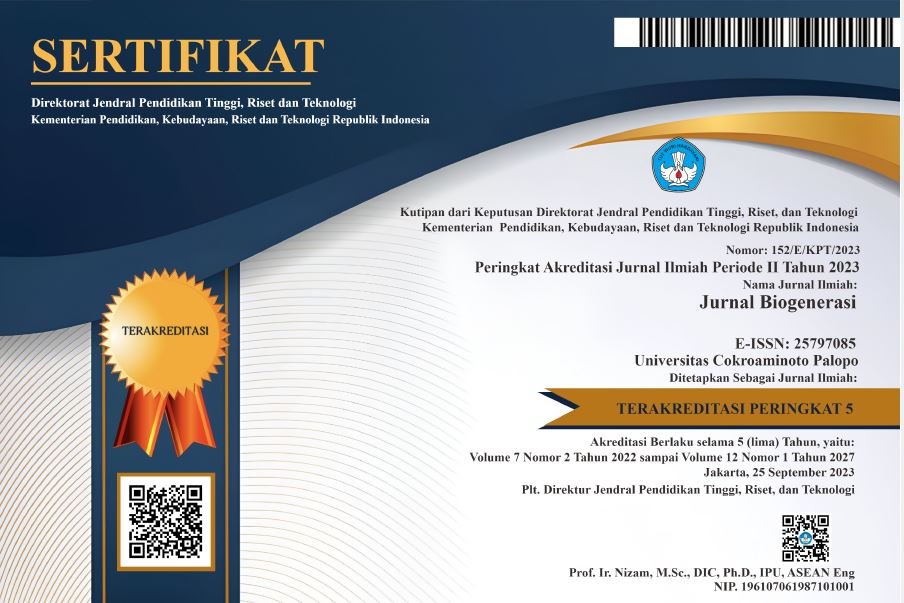KARAKTERISTIK BIOKIMIA DAN MIKROBIOLOGI PADA LARUTAN FERMENTASI KEDUA KOMBUCHA BUNGA TELANG (Clitoria ternatea L) SEBAGAI INOVASI PRODUK BIOTEKNOLOGI TERKINI
DOI:
https://doi.org/10.30605/biogenerasi.v7i2.1765Keywords:
Bunga Telang, Kombucha, Added HoneyAbstract
Salah satu kandungan bunga telang (Clitoria ternatea L) yaitu berupa antosianin yang memiliki potensi sebagai antioksidan dan antibakteri. Bunga telang dapat diolah menjadi minuman kombucha yang merupakan inovasi produk bioteknologi terkini dari kayak nya karakteristik biokimia dan mikrobiologi. Penambahan madu jenis Clover Honey dapat dimanfaatkan sebagai pemanis serta sumber nutrisi yang baik bagi tubuh dalam pembuatan minuman kombucha bunga telang pada fermentasi kedua. Oleh karena itu, dalam penelitian ini kombucha bunga telang yang telah dipanen selama 2 minggu lalu ditambahkan madu Clover Honey selama waktu tambahan 7 hari yaitu 21 hari. Metode yang digunakan dalam penellitian ini adalah Rancangan Acak Kelompok (RAK) yang dibagi menjadi dua faktor. Faktor I merupakan fermentasi kombucha bunga telang berumur 1 minggu pada konsentrasi gula (20%, 30%, dan 40%) dan faktor II yaitu fermentasi kombucha bunga telang dengan penambahan madu Clover Honey pada konsentrasi madu (20%, 30%, dan 40%). Data yang diperoleh dari penelitian dianalisis menggunakana ANOVA dan apabila terdapat interaksi antara kedua faktor maka dilanjutkan dengan uji lanjut BNT (Beda Nyata Terkecil) atau DMRT 5%. Hasil yang telah diperoleh setelah kombucha bunga telang difermentasi selama 21 hari yaitu konsentrasi madu berpengaruh nyata (α= 0,05) terhadap nilai total asam, pH, total fenol, total total gula, dan total mikroba. Perlakuan terbaik diperoleh yaitu pada adalah konsentrasi 40% yaitu total asam 1,88%, total fenol 115,71 ppm, total gula 23.53%, dan total mikroba 8,01 log CFU/mL. Perlakuan terbaik untuk mengetahui karakteristik mikrobiologi pada kombucha bunga telang (Clitoria ternatea L) selama fermentasi kedua dan pasca ditambahkan madu Clover Honey adalah konsentrasi 40%. Aktivitas antibakteri pada Staphylococcus aureus memiliki rata-rata diameter zona hambat sebesar 17,54 mm dengan kategori kuat. Pada bakteri Staphylococcus epidermidis zona hambat sebesar 16,73 mm dengan kategori kuat. Zona hambat sebesar 15,96 mm pada bakteri Pseudomonas aeruginosa dengan kategori kuat. 15,26 mm pada bakteri Escherichia coli dengan kategori kuat. Karakteristik biokimia dan mikrobiologi yang dihasilkan oleh kombucha bunga telang melalui fermentasi yang kedua merupakan salah satu terobosan baru untuk menciptakan inovasi produk bioteknologi terkini.
Downloads
References
Allison, D. G., & Lambert, P. A. (2015). Modes of action of antibacterial agents.In Molecular Medical Microbiology (pp. 583–598).Elsevier. https://doi.org/10.1016/B978-0-12-397169-2.00032-9.
Battikh, H., Chaieb, K., Bakhrouf, A., & Ammar, E. (2013).Antibacterial and antifungal activities of black and green kombucha teas. Journal of Food Biochemistry, 37(2), 231–236. https://doi.org/10.1111/j.1745-4514.2011.00629.x
Borkani, R. A., Doudi, M., & Rezayatmand, Z. (2016). Study of the Anti-Bacterial Effects of Green and Black Kombucha Teas and Their Synergetic Effect against Some Important Gram Positive Pathogens Transmitted by Foodstuff. International Journal of Advanced Biotechnology and Research, 7, 1741–1747. https://bipublication.com/files/201603207Monir.pdf.
Beek, S.V., and F.G. Priest. 2000. Decarboxylation of Substituted Cinnamic Acid by Lactic Acid Bacteria Isolated During Malt Whisky Fermentation. Applied and Eviromental Microbiology. Des. 2000: 5322-5328.
Chayati, I., dan Isnati M. 2014. Kandungan Komponen Fenolat, Kadar Fenolat, dan Aktivitas Antioksidan Madu dari Beberapa Daerah di Jawa dan Sumatera. Universitas Negeri Yogyakarta. Yogyakarta
Dibyanti, P., Radiati, L. E., & Rosyidi, D. (2014).Effect of Addition of Various Concentrations of Culture & Incubation Period on pH, Acidity Levels, Viscosity & Syneresis Set Yoghurt. Jurnal Ilmu Ternak, 1–6. https://doi.org/10.1016/S0308-8146(01)00201-1
Frank, G.W. 1996. Kombucha Healthy Beverage and Natural Remedy from The Far East. Publishing House Ennsthaler. Austria.
Hidayat, D. 2006. Mikrobiologi Industri. C.V Andi offset. Yogyakarta.
Hunaefi, D., Akumo, D. N., & Smetanska, I. (2013).Effect of fermentation on antioxidant properties of red cabbages. Food Biotechnology, 27(1), 66–85. https://doi.org/10.1080/08905436.2012.755694
Khaleil, M. M., Abd Ellatif, S., Soliman, M. H., Abd Elrazik, E. S., & Fadel, M. S. (2020). A Bioprocess Development Study of Polyphenol Profile, Antioxidant and Antimicrobial Activities Of Kombucha Enriched With Psidium guajava L. Journal of Microbiology, Biotechnology and Food Sciences, 9(6), 1204–1210. https://office2.jmbfs.org/index.php/JMBFS/article/view/4505
Konchzak, I., Zhang, W. 2014. Anthocyaninsmore than Natures Ccolours .Journal of Biomedicine and Biotechnology.Vol 5, No. 2.239-250.
Koswara, S. 2009. Madu: Jenis dan Penggunaannya. eBook Pangan Unimus. Semarang.
Kumar, V., & Joshi, V. K. (2016). Kombucha: Technology, microbiology, production, composition and therapeutic value. International Journal of Food and Fermentation Technology, 6(1), 13–24. http://dx.doi.org/10.5958/2277-9396.2016.00022.2.
Kunnaryo, H. J. B., & Wikandari, P. R. (2021).Antosianin dalam Produksi Fermentasi dan Perannya sebagai Antioksidan. 10(1), 24–36. https://ejournal.unesa.ac.id/index.php/unesa-journal-of- chemistry/article/view/40298.
Loypimai, P., Moongngarm, A., & Chottanom, P. (2016). Thermal and pH degradation kinetics of anthocyanins in natural food colorant prepared from black rice bran. Journal of Food Science and Technology, 53(1), 461–470. https://doi.org/10.1007/s13197-015-2002-1
Malbasa, R., Loncar, E., dan M. Djuric. 2008. Comparison of the Products of Kombucha
Fermentation on Sucrose and Milasses.Journal Food Chemistry.Vol. 106, p. 1039- 1045.
Manaroinsong, A. (2015). Uji daya hambat ekstrak kulit nanas (Ananas comosus L) terhadap bakteri Staphylococcus aureus secara in vitro.Pharmacon, 4(4).https://ejournal.unsrat.ac.id/index.php/pharmacon/article/view/10188
Marwati, H. S., & Handria, R. (2013).Pengaruh Konsentrasi Gula dan Starter terhadap Mutu Teh Kombucha. Jurnal Teknologi Pertanian, 8(02), 49–53. https://jtpunmul.files.wordpress.com/2014/03/2-vol-8-no-2-marwati.pdf
Murti, T.W. 2007.Kajian Cita Rasa dan Ragam Asam Organik Fermentasi Susu Kambing Menggunakan Bakteri Lactobacillus casei. J. Indon. Trop. Anim. Agric. 32 (4).
Panda, S. H., Parmanick, M., & Ray, R. C. (2007).Lactic acid fermentation of sweet potato (Ipomoea batatas L.) into pickles. Journal of Food Processing and Preservation, 31(1), 83–101. https://doi.org/10.1111/j.1745-4549.2007.00110.x
Pertiwi, F. D., Rezaldi, F., & Puspitasari, R. (2022). Uji Aktivitas Antibakteri Ekstrak Etanol Bunga Telang (Clitoria ternatea L.) Terhadap Bakteri Staphylococcus epidermidis. BIOSAINTROPIS (BIOSCIENCE-TROPIC), 7(2), 57-68. https://doi.org/10.33474/e-jbst.v7i2.471
Rezaldi, F., Maruf, A., Pertiwi, F. D., Fatonah, N. S., Ningtias, R. Y., Fadillah, M. F., Sasmita, H., & Somantri, U. W. (2021). Narrative Review: Kombucha’s Potential As A Raw Material For Halal Drugs And Cosmetics In A Biotechnological Perspective. International Journal Mathla’ul Anwar of Halal Issues, 1(2), 43–56. https://doi.org/10.30653/ijma.202112.25
Rezaldi, F., Taupiqurrohman, O., Fadillah, M. F., Rochmat, A., Humaedi, A., & Fadhilah,F. (2021). Identifikasi Kandidat Vaksin COVID-19 Berbasis Peptida dari Glikoprotein Spike SARS CoV-2 untuk Ras Asia secara In Silico. Jurnal Biotek Medisiana Indonesia, 10(1), 77–85. https://doi.org/10.22435/jbmi.v10i1.5031
Rezaldi. F, Ningtias. R.Y, Anggraeni.S.D, Ma’ruf.A, Fatonah.N.S, Pertiwi.F.D, Fitriyani. A. Lucky. D, US. Sunarlin, Fadillah. M.F, Subekhi.A.I.2021 Pengarujh Metode Bioteknologi Fermentasi Kombucha Bunga Telang (Clitoria ternatea L) Sebagai Antibakteri Gram Positif Dan Negatif. Jurnal Biotek. 9 (2).https://doi.org/10.24252/jb.v9i2.25467
Rosita. 2007. Berkat Madu. Qanita. Bandung
Saati, E. A. (2016). Antioxidant power of rose anthocyanin pigment. ARPN Journal of Engineering and Applied Sciences, 11(17), 1201–1204. https://eprints.umm.ac.id/57868/
Sarwono B. 2001. Kiat Mengatasi Permasalahan Praktis Lebah Madu. AgroMedia. Jakarta.
Shereen, M. A., Khan, S., Kazmi, A., Bashir, N., & Siddique, R. (2020). COVID-19 infection: Origin, transmission, and characteristics of human coronaviruses. Journal of Advanced Research, 24, 91. https://dx.doi.org/10.1016%2Fj.jare.2020.03.005
Simanjuntak, R., & Siahaan, N. (2011).Pengaruh Konsentrasi Gula dan Lama Fermentasi Terhadap Mutu Teh Kombucha. Jurnal Ilmiah Pendidikan Tinggi, 4(2), 81–91. http://akademik.uhn.ac.id/portal/public_html/JURNAL/Jurnal_Rosnawyta_Sima njuntak/Juridikti%20Edit.pdf
Sreeramulu, G., Zhu, Y., & Knol, W. (2000).Kombucha fermentation and its antimicrobial activity.Journal of Agricultural and Food Chemistry, 48(6), 2589– 2594. https://doi.org/10.1021/jf991333m. https://doi.org/10.1021/jf991333m
Suhardini, P. N., & Zubaidah, E. (2015).Studi Aktivitas Antioksidan Kombucha Dari Berbagai Jenis Daun Selama Fermentasi [In Press Januari 2016]. Jurnal Pangan Dan Agroindustri, 4(1). https://jpa.ub.ac.id/index.php/jpa/article/view/322.
Suranto, A. 2004.Khasiat & Manfaat Madu Herbal. AgroMedia Pustaka. Jakarta.
Utami, S. R., Eva Pamungkas S., dan Inayati. 2014. Pengaruh Waktu Hidrolisa dan Konsetrasi Asam Pada Hidrolisa Pati Kentang dengan Katalis Asam. Universitas Sebelas Maret. Surakarta.
Wiczkowski, W., Szawara-Nowak, D., & Topolska, J. (2015).Changes in the content and composition of anthocyanins in red cabbage and its antioxidant capacity during fermentation, storage and stewing. Food Chemistry, 167, 115–123. https://doi.org/10.1016/j.foodchem.2014.06.087
Yanti, N. A., Ambardini, S., Ardiansyah, A., Marlina, W. O. L., & Cahyanti, K. D. (2020). Aktivitas Antibakteri Kombucha Daun Sirsak (Annona muricata L.) Dengan Konsentrasi Gula Berbeda. Berkala Sainstek, 8(2), 35–40. https://doi.org/10.19184/bst.v8i2.15968.
Downloads
Published
How to Cite
Issue
Section
License
In submitting the manuscript to the journal, the authors certify that:
- They are authorized by their co-authors to enter into these arrangements.
- The work described has not been formally published before, except in the form of an abstract or as part of a published lecture, review, thesis, or overlay journal.
- That it is not under consideration for publication elsewhere,
- That its publication has been approved by all the author(s) and by the responsible authorities – tacitly or explicitly – of the institutes where the work has been carried out.
- They secure the right to reproduce any material that has already been published or copyrighted elsewhere.
- They agree to the following license and copyright agreement.
License and Copyright Agreement
Authors who publish with this journal agree to the following terms:
- Authors retain copyright and grant the journal right of first publication with the work simultaneously licensed under Creative Commons Attribution License (CC BY 4.0) that allows others to share the work with an acknowledgment of the work's authorship and initial publication in this journal.
- Authors are able to enter into separate, additional contractual arrangements for the non-exclusive distribution of the journal's published version of the work (e.g., post it to an institutional repository or publish it in a book), with an acknowledgment of its initial publication in this journal.
- Authors are permitted and encouraged to post their work online (e.g., in institutional repositories or on their website) prior to and during the submission process, as it can lead to productive exchanges, as well as earlier and greater citation of published work.


.png)

